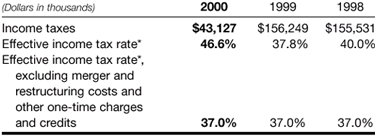| |
|||
| |
|
|
|
| |
|||||||||
|
|||||||||
|
General and Administrative Expenses
Our general and administrative expenses consist primarily of personnel-related costs associated with support functions. Because these functions, for the most part, support all segments of our business, we do not consider these costs in determining our segment profitability. Throughout 2000 and 1999, we developed our infrastructure, particularly in the areas of Supply Chain Management, MIS, and International. These areas were significant contributors to the increases in our general and administrative expenses in the last two years. The primary benefits derived from this increased spending were the expansion and improvement of our e-commerce services, a new data center, improvements in our inventory in-stock positions and support for our rapidly growing International Division. Also contributing to the growth, particularly in 1999, was spending to support our Year 2000 (“ Y2K”) efforts and CSC consolidation and integration initiatives. Other Income and Expense
We do not consider interest income and expense arising from our financing activities at the corporate level in determining segment profitability. Pursuant to our Board of Directors authorizing stock repurchases in the latter half of 1999 and 2000, we have purchased approximately 82 million shares of our stock at a total cost of $800 million plus commissions. As a result, our cash balances have declined, and our interest income has decreased in 2000. The increases in interest income in 1999 and 1998 resulted from improved supply chain initiatives in 1998, which yielded higher average cash balances throughout 1998 and most of 1999. During the fourth quarter of 2000, we began borrowing against our domestic credit facility (see Liquidity and Capital Resources), which led to increased interest expense over 1999. Also, as we set up reserves for future lease obligations related to our facility closures and merger activities, we recorded those reserves at the net present value of the obligation. In 2000, as we have been paying these obligations, we have been recording the imputed interest cost on the discounted obligations as interest expense. This has also caused interest expense to increase and should be expected to continue in future years. During 1999, we entered into a number of capital leases, primarily related to new point-of-sale equipment in our stores, which also drove the increase in interest expense over 1998. Our net miscellaneous income (expense) consists of equity in the earnings (losses) of our joint venture investments, royalty and franchise income that we generate from licensing and franchise agreements and the amortization of goodwill. All of our equity investments involve operations outside of the United States and Canada, and our equity in the earnings (losses) of these operations is included in determining the profitability of our International Division. Our net miscellaneous income in 2000 is attributable to our profitable joint venture operations in Mexico and Israel. The decrease in net miscellaneous expense in 1999 from 1998 is primarily attributable to the consolidation of our French and Japanese retail operations beginning in the fourth quarter of 1998 and second quarter of 1999, respectively, when we purchased the remaining 50% interest from our joint venture partners. Prior to that consolidation, we recorded equity losses related to the start-up of those operations. Income Taxes 
In 2000, 1999 and 1998, certain non-deductible merger-related and other one-time charges caused our overall effective income tax rates to rise. Our overall effective income tax rate, excluding these charges, may fluctuate in the future as a result of the mix of pre-tax income and tax rates between countries. Liquidity and Capital Resources Cash provided by (used in) our operating, investing and financing activities is summarized as follows:
Operating and Investing Activities We historically have relied on cash flow generated from operations as our primary source of funds because the majority of our store sales are generated on a cash and carry basis. Furthermore, we use private label credit card programs, administered and financed by financial services companies, to expand our sales without the burden of carrying additional receivables. Our cash requirements are also reduced by vendor credit terms that allow us to finance a portion of our inventory. We generally offer credit terms, under which we carry our own receivables, to our contract and certain of our direct mail customers. As we expand our contract and direct mail businesses, we anticipate that our accounts receivable portfolio will continue to grow. Amounts due for rebate, cooperative advertising and marketing programs with our vendors comprise a significant percentage of our total receivables. These receivables tend to fluctuate seasonally (growing during the second half of the year and declining during the first half), because certain collections do not happen until after an entire program year has been completed.
|